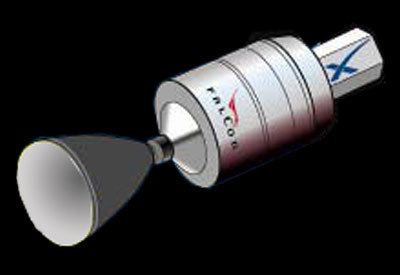Mission type DemoSat/Boilerplate COSPAR ID 2008-048A Rocket Falcon 1 F4 Inclination 9.35° Launch mass 165 kg Launch site Omelek Island | Operator SpaceX SATCAT no. 33393 Contractor SpaceX Period 1.6 hours Launch date 28 September 2008 Manufacturer SpaceX | |
 | ||
Similar FalconSAT‑2, SpaceX COTS De, NanoSail‑D, RazakSAT, AsiaSat 8 | ||
Ratsat, or DemoSat, was a 165-kilogram (363-pound) non-functional boilerplate spacecraft used as a mass simulator on the fourth flight of the Falcon 1 rocket.
Contents
Ratsat was carried to orbit on the first successful orbital launch of any privately funded and developed, liquid-propelled carrier rocket, the SpaceX Falcon 1.
The launch, identified as Falcon 1 Flight 4, was conducted by SpaceX, and also marked the first time the Falcon 1 rocket successfully achieved orbit, after three consecutive failures on the three previous launch attempts.
Ratsat remained bolted to the second stage of the carrier rocket after reaching low Earth orbit. It has a hexagonal prism shape, 1.5 m (5 ft) long. SpaceX co-founder Elon Musk estimates that Ratsat will remain in orbit for between five and ten years before burning up in the atmosphere.
Preparations
When the fourth flight was first announced in August 2008, shortly after the third flight failed, it was planned for launch in September. The rocket that was used to conduct the test flight was originally built to launch the RazakSAT satellite. The test flight was introduced into the launch schedule because Astronautic Technology Sdn Bhd (ATSB) required a successful flight to be conducted before RazakSAT could be launched.
The schedule left very little time for modifications and testing. The rocket was shipped to the company's testing facilities in Texas where, after less than 24 hours, it was certified for launch. SpaceX chartered a United States Air Force C-17 flight on 3–4 September to carry both stages of the rocket 9,700 km (6,000 mi) to the launch facilities at the Kwajalein Atoll. The Falcon 1 rocket was successfully test-fired on 20 September. Launch preparations on 23 September led the ground crew to replace part of a pipeline supplying liquid oxygen to the second stage Kestrel engine. This work delayed the launch to 28 September.
Launch
The launch occurred from Omelek Island, part of the Kwajalein Atoll in the Marshall Islands. Liftoff occurred at 23:15 UTC on 28 September, 15 minutes into a five-hour launch window. If the launch had been scrubbed, it could have been conducted during the same window until 1 October. Nine minutes and 31 seconds after launch, the second stage engine shut down, after the vehicle reached orbit. The initial orbit was reported to be about 330 x 650 km. Following a coast period, the second stage restarted, and performed a successful second burn, resulting in a final orbit of 621 x 643 km x 9.35°.
It was Falcon 1's first successful launch, and the first successful orbital launch of any privately funded and developed, liquid-propelled carrier rocket.
The rocket followed the same trajectory as the previous flight, which failed to place the Trailblazer, NanoSail-D, PRESat and Celestis Explorers spacecraft into orbit. No major changes were made to the rocket, other than increasing the time between first stage burnout and second stage separation. This minor change addressed the failure seen on the previous flight, recontact between the first and second stages, by dissipating residual thrust in the first stage engine before separating them.
Although SpaceX intended to recover the first stage of Falcon 1 launch vehicles, as of this launch, they had not yet succeeded in doing so. Stage recovery was a non-primary goal of the early flights. SpaceX is utilizing an incremental development process to work the design issues with stage recovery and CEO Elon Musk stated that the probability of a successful recovery would have increased with subsequent flights, however the Falcon 1 was subsequently retired from service after its fifth launch, with first stage recovery never having been accomplished successfully. The successor rocket, the Falcon 9, landed its first stage successfully on land for the first time on its twentieth flight, on December 22, 2015.
